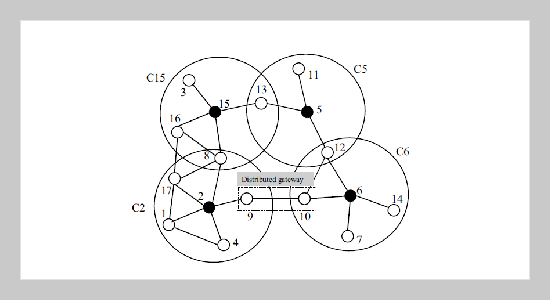REFERENCES
- [1] Murthy, C. S. R. and Manoj, B. S., Ad Hoc Wireless Networks: Architectures and Protocols, Prentice Hall (2004).
- [2] Iwata, A., Chiang, C. C., Pei, G., Gerla, M. and Chen, T. W., “Scalable Routing Strategies for Ad hoc Wireless Networks,” IEEE J. Select. Areas Commun., Vol. 17, pp. 1369�1379 (1999).
- [3] Krishna, P., Vaidya, N., Chatterjee, M. and Pradhan, D., “A Cluster-Based Approach for Routing in Dynamic Networks,” ACM SIGCOMM Computer Commnications Review, Vol. 27, pp. 49�64 (1997).
- [4] McDonald, B. and Znati, T. F., “A Mobility-Based Framework for Adaptive Clustering in Wireless Ad hoc Networks,” IEEE J. Select. Areas Commun., Vol. 17, pp. 1466�1487 (1999).
- [5] Ramanathan, R. and Steenstrup, M., “Hierarchically-Organized, Multihop Mobile Wireless Networks for Quality-of-Service Support,” ACM/Baltzer Mobile Networks and Applications, Vol. 3, pp. 101� 119 (1998).
- [6] Gerla, M. and Tsai, J., “Multicluster, Mobile, Multimedia Radio Network,” ACM/Baltzer Journal of Wireless Networks, Vol. 1, pp. 225�238 (1995).
- [7] Lin, C. R. and Gerla, M., “Adaptive Clustering for Mobile Wireless Networks,” IEEE J. Select. Areas Commun., Vol. 15, No. 7, pp. 1265�1275 (1997).
- [8] Basagni, S., “Distributed Clustering for Ad hoc Networks,” Proceedings of IEEE I-SPAN, pp. 310�315 (1999).
- [9] Basagni, S., “Distributed and Mobility-Adaptive Clustering for Multimedia Support in Multi-Hop Wireless Networks”, Proceedings of the IEEE Vehicular Technology Conference (VTC) 1999, Amsterdam, The Netherlands (1999).
- [10] Basagni, S., “Distributed and Mobility-Adaptive Clustering for Ad hoc Networks,” Erik Jonsson School of Engineering and Computer Science, The University of Texas at Dallas, Tech. Rep. UTD/EE-02-98 (1998).
- [11] Hou, T. C. and Tsai, T. J., “An Access-Based Clustering Protocol for Multihop Wireless Ad hoc Networks,” IEEE J. Select. Areas Commun., Vol. 19. pp. 1201�1210 (2001).
- [12] Agarwal, S., Ahuja, A., Singh, J. P. and Shorey, R., “Route-Lifetime Assessment Based Routing (RABR) Protocol for Mobile Ad hoc Networks,” Proceedings of IEEE ICC 2000, Vol. 3, pp. 1697�1701 (2000).
- [13] Dube, R., Rais, C. D., Wang, K. Y. and Tripathi, S. K., “Signal Stability-Based Adaptive Routing (SSA) for Ad hoc Mobile Networks,” IEEE Personal Communications Magazine, Vol. 4, pp. 36�45 (1997).
- [14] Paul, K., Bandyopadhyay, S., Mukherjee, A. and Saha, D., “Communication-Aware Mobile Hosts in Ad hoc Wireless Network,” IEEE International Conference on Personal Wireless Communication, pp. 83�87 (1999).
- [15] Tien, T. C. and Upadhyaya, S. J., “A Local/Global Strategy Based on Signal Strength for Message Routing in Wireless Mobile Ad hoc Networks,” Proceedings of IEEE Academia/Industry Working Conference on Research Challenges, pp. 227�232 (2000).
- [16] Singh, S., Woo, M. and Raghavendra, C., “PowerAware Routing in Mobile Ad hoc Networks,” Proceedings of the Fourth Annual ACM/IEEE International Conference on Mobile Computing and Networking (MobiCom98), pp. 181�190 (1998).
- [17] Toh, C. K., “Maximum Battery Life Routing to Support Ubiquitous Mobile Computing in Wireless Ad hoc Networks, ” IEEE Communications Magazine, Vol. 39, pp. 138�147 (2001).
- [18] Tragoudas, S. and Dimitrova, S., “Routing with Energy Considerations in Mobile Ad hoc Networks,” IEEE Wireless Communications and Networking Conference (WCNC 2000), Vol. 3, pp.1258�126 (2000).
- [19] Sivakumar, R., Sinha, P. and Bhagravan, V., “CEDAR: A Core Extraction Distributed Ad hoc Routing Algorithm,” IEEE J. Select. Areas Commun. Vol. 17, pp. 1454�1465 (1999).
- [20] Chen, G., Nocetti, F. G., Gonzalez, J. S. and Stojmenovic, I., “Connectivity Based K-hop Clustering in Wireless Networks,” Proceedings of the 35th Hawaii International Conference on System Science (2002).
















